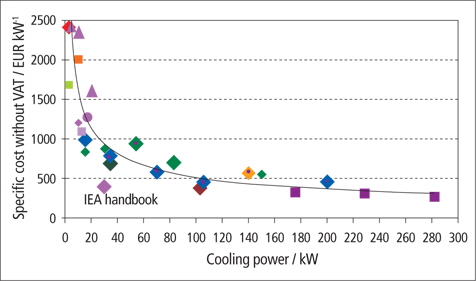



Abstract concept of sustainable development must be translated into concrete measures in the form of policies, programs and activities carried out jointly by the government, private sector and society at large. Various models of synergy between economic and environmental concept is growing in almost all countries as a model of eco-development, eco-efficiency, cleaner production, eco-industrial areas as well as regional development model of eco-innovation. In general these models aim to integrate the economic interests on the one side with protecting the environment on the other side.
As a new concept, eco-innovation model is exclusive, becuse it is not only related to the technical aspects of the environment, but also it includes the realm of management, policy and social innovation. The concept of eco-innovation by OECD (2009) is “the creation or adoption of new, or significantly improved products (goods and services), processes, marketing methods, organizational and institutional structures, as well as rules aimed at keeping the environmental improvement as compared to alternative relevant”. Sarkar (2013) concluded that the various definitions that developed the concept of eco-innovation can be divided into two categories: non-environmental innovation and environmental innovation. In terms of development, sustainable environment innovation becomes very important. This concept can also be classified into: eco-technology innovation, eco-innovation organization, innovation related to the business district and social innovation.
At the meso level, the eco-industrial park can also be referred to as eco-innovation park. Sakr et al. (2011) stated that the critical success factors of eco-industries park around the world are covering partnership relationship, economic value added, policies and regulations, awareness and information, establishment of institutional and organizational, and technical factors. Andersen (2006) makes classification of eco-innovation into 5 categories as follows: Add-on innovation, integrated innovation, eco-efficient technological system, eco-organizational system and general purpose eco-efficient innovations. Therefore, the study of water, energy and waste are based on the add-on innovation category. The product of technology in this study comes from and has been developed by researchers in PUSPIPTEK.
Center for Research of Science and Technology “PUSPIPTEK” is a national strategic area that has tremendous potential for the development of science and technology, economic, social and environmental. The growing development of South Tangerang city includes the expansion of residential areas, industrial and office growth, and these development areas will bring tremendous consequences to changes in land use, the environment, biodiversity and socio-cultural systems. The model of policy for Development of PUSPIPTEK Eco-Innovation area is a model of an integrated policy covering the management of water, energy and waste, regional management model and the institutional model with the concept of eco-innovation that PUSPIPTEK area will be an integrated sustainable science and technology area.
The purpose of this research is to build a model of policy for eco-innovation development in the PUSPIPTEK area. The specific objectives are:
1. Knowing the existing condition of water, energy and waste management at the PUSPIPTEK area. 2. Develop a submodel of water, energy and waste management to the eco-innovationconcept.
The model of policy is expected to help policy makers (central and local government), actors of science and technology, industries and other parties who are interested in the eco-innovation development in PUSPIPTEK.
Research on specific areas of center for research of science and technology as well as national vital and strategic objects have a very high complexity in the management area that needs to be formulated in an integrated system. In the region there is a research nuclear reactor, research centers for physics, chemistry, biotechnology and others. Those require an integrated environmental management policy in order to provide security and comfort for the people who are inside and outside the region. The research model of policy for eco-innovation in PUSPIPTEK region has never been done. Therefore, from aspect of the concept approach and location, this research has a novelty.
A model of policy for eco-innovation development in PUSPIPTEK with the eco-innovation of water, energy and waste management is the novelty of this research.
As a center for research of science and technology, every stage of its activity in PUSPIPTEK requires lots of high quality of material, energy and water resources. Meanwhile, PUSPIPTEK still used conventional method to provide energy, water and other material, in order to fulfill the need of laboratory and utility areas until recently. If this condition is continued, it will threathen the future activities in PUSPIPTEK. For example, PUSPIPTEK is very dependent on Cisadane river as a resource for water, however the status of Cisadane river is worsening due to the river becoming polluted. In addition, the process of research and technology development at the same time generates solid and liquid waste or hazardous materials. Therefore, to sustain overall activities in PUSPIPTEK, there is a need to develop policy to preserve the environmental and synergy with development activities in the area of PUSPIPTEK by designing sustainable ecology through innovation.
2.2 Place and Time of Research
The research model of policy fordevelopment eco-innovation park is in the Science & Technology Research Center (PUSPIPTEK), South Tangerang City. This study was conducted in June 2013 to December 2013.
2.3 Data Processing Techniques
1. Data processing techniques were performed with the following stages: (i) Analysis of water management by calculating quantitative of water management with eco innovation, (ii) determining of infrastructure investment based on eco-infrastructure concept, including the provision of alternative sources of water from the overflow of rain water, (iii) calculating water treatment cost savings by using innovation in the process production of water drainage via gravity process without the use of pumps; (iv) analysing financial water management based on eco innovation. In addition to the above stages, the analysis of eco energy management innovations, which includes quantitative calculation of energy use and the use of LED lights with AC with Solar Cell; is also necessary. This can be calculated for saving the cost based on energy management efficiency. 2. Analysis of the eco-innovation of waste management, which includes domestic waste, by composting method for organic waste and waste management feasibility of composting techniques.
3.1 Analysis submodel Eco-innovation of Water Management
Water is a part of the natural resources controlled by the state and used for the welfare of the people in a sustainable manner, as set forth in article on paragraph 3 of the Indonesian Constitution. The Republic of Indonesian (1960) confirms that earth, water and air space, including natural resources contained within the territory of the Republic of Indonesia are gifts of God Almighty and national treasures. The water resources for multipurpose benefits welfare of the entire people in all areas of social, economic, cultural, political, and national security fields. Definition of conservation of water resources is an effort to maintain the existence and continuity of the state, the nature and function of water resources in order to be always available in sufficient quantity and quality to meet the needs of living things, both at present and in the future.
Water conservation can be interpreted as efforts to increase the amount of ground water that goes into the ground and to create efficient water use. Each treatment given on a piece of land will affect the water system at the site and downstream areas. Soil and water conservation are two things that are very closely related, so it may be said that the various soil conservation measures are also water conservation measures (Arsyad 2000).
The eco-innovation concept in water management at PUSPIPTEK is to create the ponds (“embung”) as a water source outside Cisadane used today. Ponds also serve as a rainwater. Water from the ponds flows by gravity to the piping system to the water treatment facility. This model provides cost savings compared to the drainage of water from the river Cisadane using an electric pump. Data of the water processing in PUSPIPTEK currently is presented in <Table 1> below. The existence of ponds in the PUSPIPTEK area presented in <Fig. 1> below.
[Table 1.] Data of the water processing in PUSPIPTEK
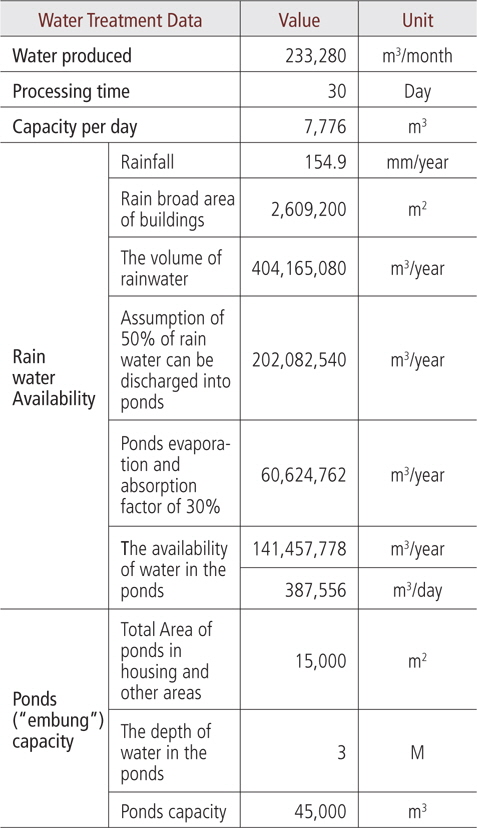
Data of the water processing in PUSPIPTEK
The feedstock of water is assumed to be 30% of the total requirement based on
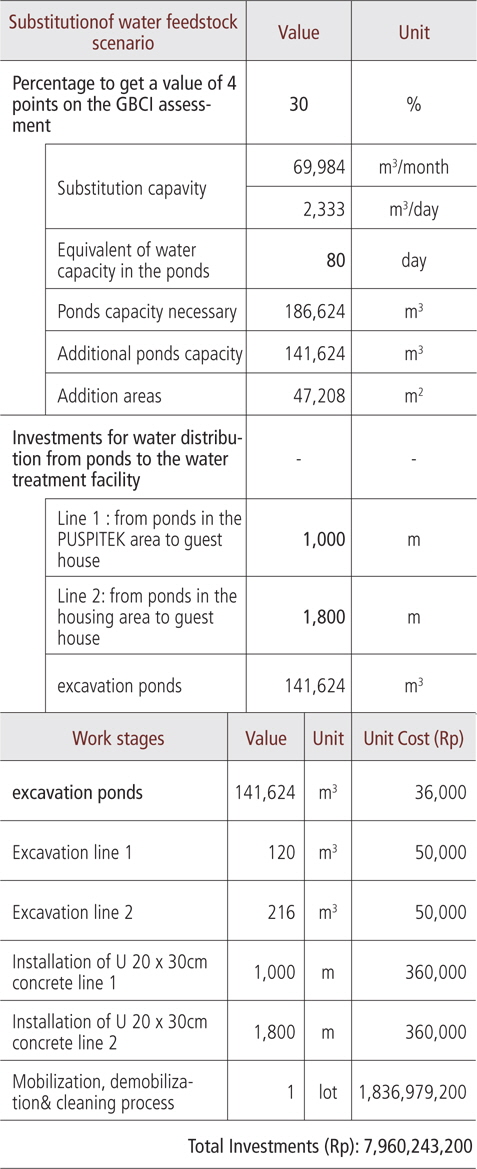
Investments and expenses necessary for the substitution of 30% water of the total requirement
The cost savings derived from electricity for pumping and chemical costs. The calculation saving that can be achieved is presented in <Table 3> below. The savings that can be achieved with the implementation of the eco-innovation water management per day is Rp. 3,032,640 or Rp. 1,106,913,600 per year. Similar funding has been found; Zaenuri (2009) concluded that by implementing water management in farmacytical industry has been generating cost efficiency 57.5% per a year.
[Table 3.] Results of Calculation of Water Production Cost Savings with Eco-Innovation
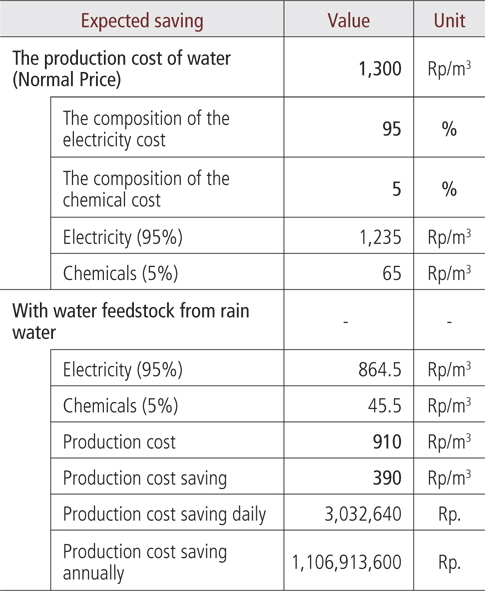
Results of Calculation of Water Production Cost Savings with Eco-Innovation
3.2 Analysis submodel Eco-Innovation Energy Management
The issue of energy crisis and global warming have become the attention of the whole world. Various technologies and innovations are being developed to find a solution. In addition to finding alternative energy sources that are environmentally friendly, energy saving is being done to reduce the rate of energy consumption. Solution of energy crisis is not only coming from in terms of alternative energy production, but in terms of consumption.
Electricity consumption in buildings is most used by the air cooling system. The conventional air-conditioning (AC) consumes relatively very large energy, and requires a large electric power. In Indonesia, the majority of electricity is generated through the use of fossil fuels, so the use of conventional air conditioning has impact on the increase in greenhouse gas emissions. Furthermore, because the ambient temperature gets hotter, more and more industries, houses, and buildings use AC, thus causing the cycle of environmental destruction and the energy crisis continues.
However, inhibition of the use of air conditioning is impossible. Therefore, it is necessary that the air conditioner innovations use renewable energy sources, and eco-friendly, one of which is conditioned by solar power. Air conditioning with solar power using solar thermal cooling system cools the room by using the heat of the sun. In such systems, the boiling point of fluid is achieved by thermal compression (Akbar 2014).
To replace the compressor in a conventional refrigeration system, three components are used in the absorption cycle, i.e. absorber, pumps, and generators. Absorber is used to absorb the refrigerant vapor into the absorbent, so the two are mixed into a solution. The fluid used is water with LiBr (lithium bromide). Water and LiBr is used because they meet the criteria of the working fluid (a mixture of refrigerant and absorbent), namely :
1) The different boiling point between the refrigerant and the solution at the same great pressure. 2) Refrigerant has a high heat of vaporization and high concentration in the absorbent solution to suppress the circulation rate between the absorber and generator per-unit cooling capacity. 3) Having good transport properties, such as viscosity, thermal conductivity, and diffusion coefficient. They can generate good heat and mass transfer. 4) Both refrigerant and absorbent are non-corrosive, environmentally friendly, and inexpensive.
If the sun is not hot enough, it can also be backed up with a gas heater. Ursula Eicker and Dirk Pietruschka in “Optimisation and Economics of Solar Cooling Systems” have calculated the cost of each AC Solar Cell for Cooling Power / KW which are presented in <Fig. 2> below.
An operational cost per year for Solar Cell AC includes power delivery, electricity, and equipment maintenance and water circulation. Calculations using regression analysis to obtain the graph AC power relations and operational costs per year in Euros can be calculated in each scenario.
Comparison of the data in the conventional AC and LiBr Solar Powered AC in PUSPIPTEK with value investing and the cost savings calculation results are presented in <Table 4> below. For the implementation of eco innovation with LiBr Solar powered AC will save Rp. 1,933,992,990 per year.
[Table 4.] Calculation of savings with LiBr Solar Powered AC
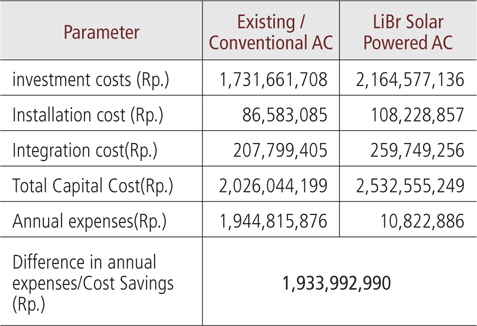
Calculation of savings with LiBr Solar Powered AC
3.3 Eco Innovation Using LED Lights
Besides saving air conditioning, it can be done by replacing the bulbs with LED bulbs with the same strong irradiation. This calculation is performed for PJU lamp in PUSPIPTEK region. For comparative analysis of cost savings results are presented in <Table 5>.
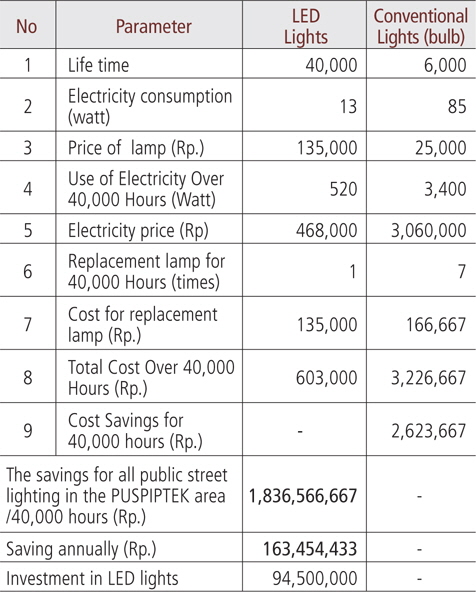
Comparison of cost savings between LED Lightsand conventional light at public street lighting in the PUSPIPTEK area
The implementation of eco-innovation in the use of LED lights at public street lighting in the PUSPIPTEK area saved Rp. 163,454,433 per year.
3.4 Analysis submodel Eco-Innovations Domestic Waste Management
PUSPIPTEK is cover areas for laboratories, offices, housing and Technology-Based Industrial Zone (development plan). The types of waste include domestic wastewater, domestic waste, laboratories waste and hazardous and toxic (B3) waste. B3 waste generated that has been handled well in PUSPIPTEK includes B3 waste from laboratories and radioactive waste from nuclear research installations.
The implementation of eco-innovation model that was carried out in the domestic waste management, was calculated on the basis of the organic waste from fallen leaves and domestic waste. This new concept is considered as a new breakthrough model which improve the behaviour of the people living in PUSPIPTEK.
Composting financial analysis has been carried out in order to calculate the net income for composting. Financial analysis in eco-innovations compost processing is presented in <Table 6> below. Revenue from composting and waste plastic sale obtained Rp. 44,016,000 per year. This study is in line with study that have been done in Simongan Industrial Park in Semarang City. The study concluded that eco-efficiency on recycle water waste in industry galvanis has made efficiency 46.2% in 2004 and 83.4% in 2008. Meanwhile, farmacytical industry developed eco-efficiency through reuse of paper, waste management of paper and CBRNE. It has been an impact to decrease cost operasional of company (Zaenuri 2009).
[Table 6 .] Financial analysis results of compost processing
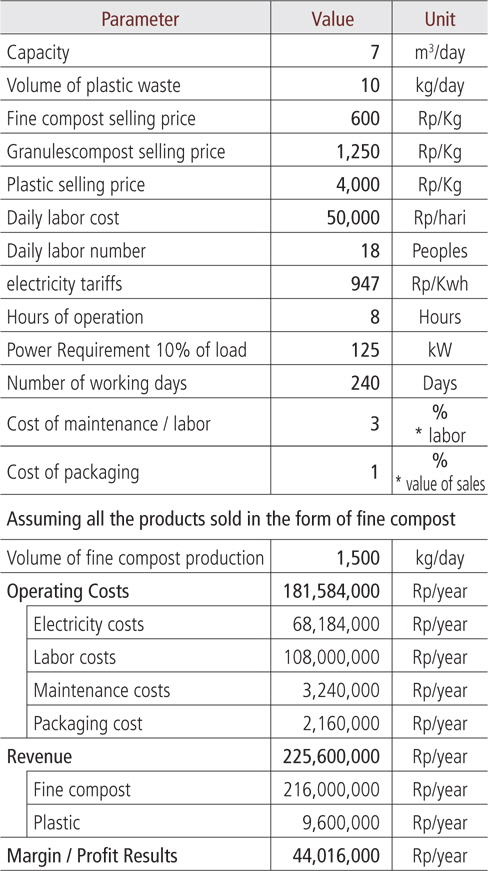
Financial analysis results of compost processing
Some of the assumptions used in the analysis of the feasibility of the implementation of the Eco Innovation are:
1) Investment cost required only in year 0 2) Maintenance cost required in year 1 to 10 3) Ponds (“embung”) maintenance fee is 5% of investment value per year 4) Increase in electricity tariff is 10% per year 5) Increase in costs & income is 10% per year
In the feasibility analysis, the savings obtained with the implementation of eco-innovation is considered as income. Fixed capital investment is calculated from the cost of equipment and other expenses incurred by the implementation of innovations in water, waste and energy management that has been previously calculated.
The feasibility analysis was performed by calculating several parameters, namely: Net Present Value (NPV), Internal Rate of Return (IRR) and Payback Period (PBP). NPV is the present value of an investment’s expected cash inflows minus the costs of acquiring the investment. IRR is the interest rate at which the net present value of all the cash flows (both positive and negative) from a project or investment equals zero. IRR is used to evaluate the attractiveness of a project or investment. PBP is the amount of time taken to break even on an investment.
This feasibility analysis generates NPV at a 15% discount factor of Rp. 3,895,228,761; IRR 23.20% and PBP 4.48 year. Based on those indicators, it can be concluded the model of eco-innovation in the area PUSPIPTEK is feasible to implement. Tian et al. (2013) have conducted study of the performance of eco-industrial park development in China. The finding shows that (1) industrial added value of 17 eco-industrial parks as whole increased by 56%; (2) for energy consumption, fresh water consumption, industrial waste water generation and solid waste production of 17 eco-industrial park as whole increased 20%, 18%, 12%, and 6% respectively. Furthermore, eco-efficiency programs in PUSPIPTEK have been designed in line with President Instruction No. 13, 2011 on Energy and Water Saving. The instruction is guidance of government office to make action plan relating to energy and water savings on their office management.
4. CONCLUSIONS AND RECOMMENDATIONS
Based on this research, a model of policy for development of eco-innovation park(case study of Center for Research of Science and Technology “PUSPIPTEK” South Tangerang City) is concluded as follows:
1) Eco-innovation on water management with scenarios water feedstock by 30% of the total requirement comes from the ponds in the area. The savings that can be achieved with the implementation of eco-innovation in the water management is Rp. 3,032,640 daily, or Rp. 1,106,913,600 per year 2) The savings derived from the implementation of eco innovation through replacement of central AC to AC LiBr Solar Powered will be Rp. 1,933,992,990 annually, and the use of LED lights in the public street lighting PUSPIPTEK saved Rp.163,454,433 per year 3) Eco-innovation in waste management will be able to raise awareness of the environment by sorting organic, inorganic and plastic waste. Composting and plastic waste obtained from the sale revenue is Rp. 44,016,000 per year 4) Overall, implementation of the eco-innovation system in PUSPIPTEK area can saves Rp. 3,248,377,023 per year, compared to the existing system. 5) The savings that are obtained with implementation of eco-innovation is considered as income. Analysis of the feasibility of the implementation of eco-innovation in water, energy, and waste management in PUSPIPTEK gives NPV at a 15% discount factor in Rp. 3,895,228,761; 23.20% of IRR and 4.48 years of PBP. Thus the model of eco-innovation in the area PUSPIPTEK is feasible to implement.
Some research suggestions in the preparation for development of eco-innovation in PUSPIPTEK area are as follows :
1) To get the title as the eco-innovation park, it is recommended that PUSPIPTEK management make the strategic planning involving consultant certified by Green Building Council Indonesia (GBCI). 2) Policy to make PUSPIPTEK as regional eco-innovation directed towards the development of infrastructure facilities of water, energy and waste management will have an impact on cost savings and increase environmental quality and comfort for the occupants of the region.




